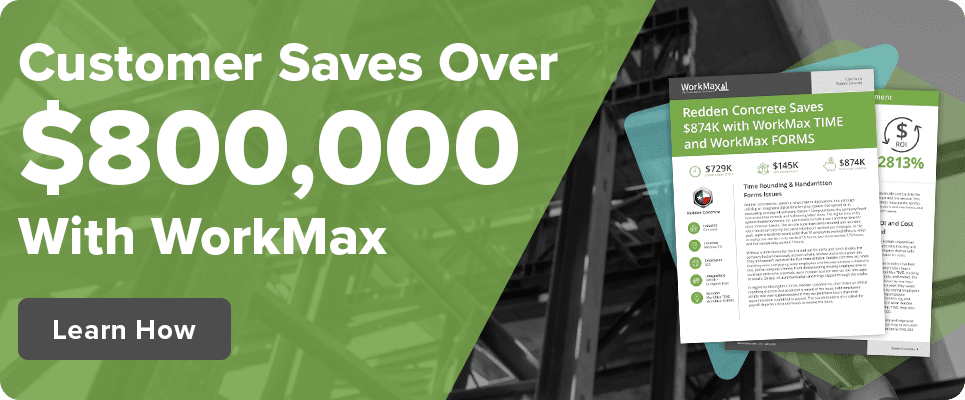Our users reported over 96% customer satisfaction for the last 10 years. Schedule a personal tour of our software to see how we can improve your business’s productivity.
Table of Contents
Share Article
Construction companies are always looking for ways to work smarter — boosting efficiency, managing labor costs and keeping projects on schedule.
But with ongoing skilled labor shortages, that’s easier said than done. In fact, the demand for construction workers is only growing.
According to the U.S. Bureau of Labor Statistics, overall employment in construction and extraction occupations is projected to grow faster than average from 2023 to 2033, with around 663,500 job openings expected each year.

So how can construction firms keep up with rising labor demands while staying efficient and cost-conscious?
One solution that’s gaining traction is multiskilling, which refers to training workers in multiple trades instead of limiting them to just one.
A multiskilled workforce offers greater flexibility, helping firms allocate resources more effectively, reduce downtime and keep projects moving.

But to manage a multiskilled workforce successfully, contractors need real-time labor tracking, cost management and compliance monitoring — which is where mobile time tracking comes in.
Let’s take a closer look at how multiskilling works in construction and why the right workforce management tool makes all the difference.
Key Takeaways for Contractors:
- Multiskilling helps mitigate labor shortages by creating a more flexible workforce.
- It can lead to cost savings by reducing downtime and optimizing labor usage.
- Real-time tracking of multiskilled labor is essential for accurate payroll, reporting and compliance.
- A time tracking mobile app like WorkMax simplifies workforce management by automating labor tracking and cost allocation.
Phase #1: Understanding Multiskilling and Its Benefits
To fully realize the advantages of multiskilling, it’s crucial to understand the fundamental ways it enhances workforce capabilities and contributes to cost savings.
Expanding Workforce Capabilities
Multiskilling allows construction workers to perform various tasks across multiple trades, such as carpentry, electrical work, plumbing and masonry.
This approach enhances workforce agility, reducing dependency on specialized labor and minimizing project delays caused by skill shortages.
Cost Savings and Improved Productivity
By reducing idle time and optimizing construction labor usage, multiskilling can lead to significant cost savings.
Instead of waiting for a specialized worker to become available, a multiskilled employee can complete the task, keeping the project on schedule.
Time tracking software helps track and document these productivity gains, providing real-time visibility into labor efficiency.
Phase #2: Implementing Multiskilling in Construction
Successfully implementing multiskilling requires careful planning and execution, particularly regarding training, certification and addressing potential challenges.
Training and Certification Requirements
To ensure proficiency, construction firms must invest in training programs that equip workers with multiple skill sets.
Certifications may be required depending on trade regulations and project requirements, making proper documentation and cost tracking essential.
Overcoming Implementation Challenges
While multiskilling offers clear advantages, some challenges include:
- Worker Resistance: Employees may be hesitant to take on additional training or responsibilities
- Licensing and Compliance: Certain tasks require specific licenses, limiting the extent to which multiskilling can be applied
- Safety Concerns: Workers must receive adequate training to safely perform tasks across different trades
A mobile app can simplify training documentation by tracking worker certifications, ensuring compliance and preventing unqualified employees from being assigned to specialized tasks.
Phase #3: Tracking Multiskilling Costs
Accurate tracking of labor costs is paramount when managing a multiskilled workforce, requiring robust tools for real-time field data and compliance.
Real-Time Labor Tracking and Cost Allocation
Multiskilling impacts labor costs, payroll and training expenses. Mobile time tracking apps helps contractors to:
- Track labor hours for workers performing multiple roles on a single project
- Manage varying pay rates based on the task performed
- Allocate labor costs in real time for more accurate job costing and real-time reporting
These capabilities collectively provide a comprehensive view of labor costs, facilitating accurate budgeting and financial management.
Compliance and Payroll Considerations
With different skill sets come different pay structures and compliance requirements, particularly for prevailing wage laws and union agreements.
Construction time tracking solutions automate wage calculations, ensure compliance and generate detailed labor reports to simplify workforce management.
Phase #4: Risk Management and Safety Considerations

Amplifying safety on construction sites and risk management are critical aspects of multiskilling, demanding meticulous attention to training and insurance.
Ensuring Proper Training
To minimize risks, construction firms must document all training and certification records. Time tracking technology allows project managers to:
- Maintain a database of worker qualifications and training history
- Ensure compliance with OSHA and industry safety standards
- Track insurance and liability costs associated with multiskilling
By maintaining detailed records, you can build a construction audit trail to ensure compliance, mitigate risks and protect both your workers and your business.
Managing Insurance and Liability
Multiskilled workers performing various tasks may impact a company’s liability coverage.
Proper documentation and job cost tracking help mitigate risks by ensuring workers are only assigned tasks for which they are trained and certified.
A mobile construction time tracking solution provides an automated system to track these assignments, reducing risk and improving overall safety management.
Phase #5: Leveraging Data for Workforce Optimization
To maximize the benefits of multiskilling, construction firms must harness the power of data to gain insights and refine their workforce strategies.
Using Real-Time Insights to Improve Efficiency
Historical labor data provides valuable insights for future project planning. Timecard software enables contractors to:
- Analyze past labor costs and productivity trends
- Refine workforce management strategies to improve efficiency
- Develop more accurate labor cost estimates for bidding
Utilizing these insights allows for continuous improvement in workforce management and project planning.

See How WorkMax Supports Multiskilling Management
Multiskilling presents a strategic advantage for construction firms looking to enhance workforce flexibility, reduce costs and improve project efficiency.
However, effectively managing multiskilled labor requires real-time tracking, automated cost allocation, and compliance monitoring — all of which WorkMax provides.
By leveraging WorkMax, contractors can accurately track labor costs, ensure compliance and gain real-time insights into workforce performance, ultimately driving profitability and operational success.
Streamline labor tracking and improve project efficiency by chatting with a specialist today to learn more about WorkMax!

